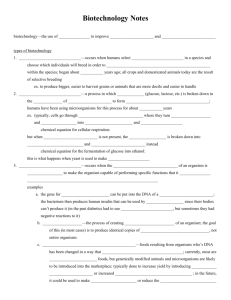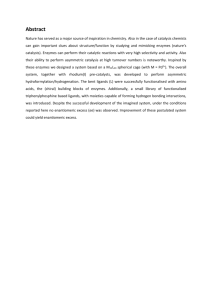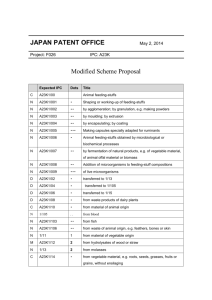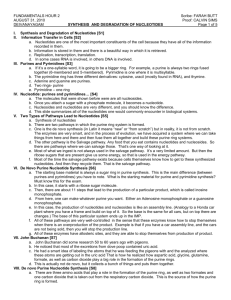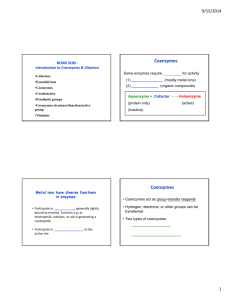Module Basis of pre
advertisement
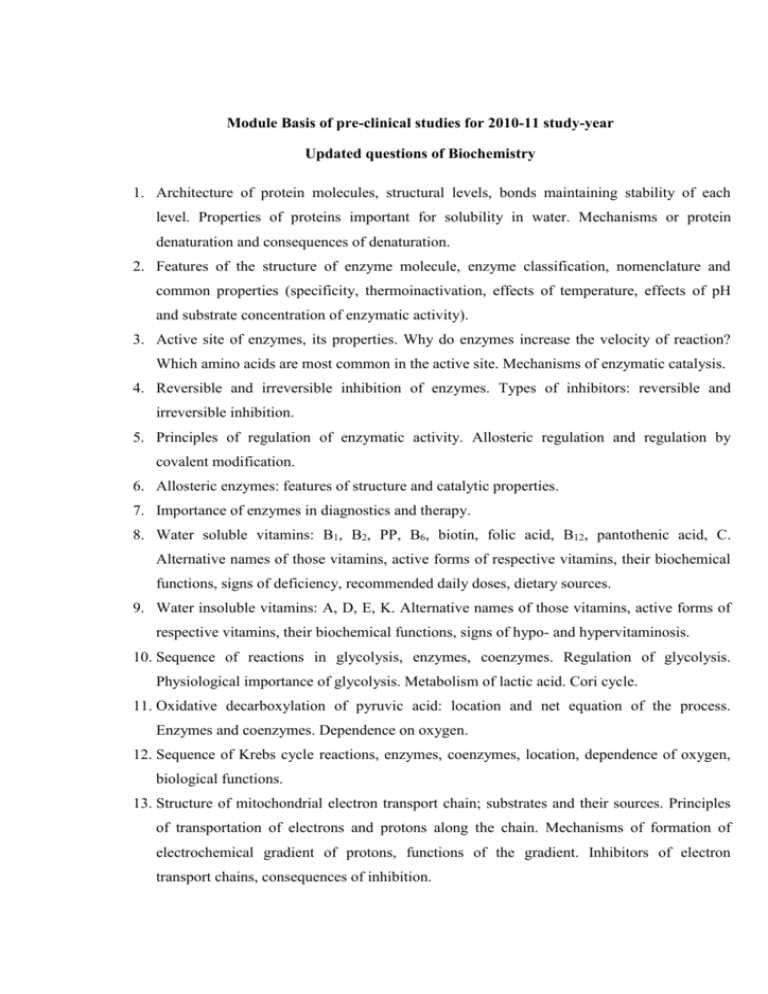
Module Basis of pre-clinical studies for 2010-11 study-year Updated questions of Biochemistry 1. Architecture of protein molecules, structural levels, bonds maintaining stability of each level. Properties of proteins important for solubility in water. Mechanisms or protein denaturation and consequences of denaturation. 2. Features of the structure of enzyme molecule, enzyme classification, nomenclature and common properties (specificity, thermoinactivation, effects of temperature, effects of pH and substrate concentration of enzymatic activity). 3. Active site of enzymes, its properties. Why do enzymes increase the velocity of reaction? Which amino acids are most common in the active site. Mechanisms of enzymatic catalysis. 4. Reversible and irreversible inhibition of enzymes. Types of inhibitors: reversible and irreversible inhibition. 5. Principles of regulation of enzymatic activity. Allosteric regulation and regulation by covalent modification. 6. Allosteric enzymes: features of structure and catalytic properties. 7. Importance of enzymes in diagnostics and therapy. 8. Water soluble vitamins: B1, B2, PP, B6, biotin, folic acid, B12, pantothenic acid, C. Alternative names of those vitamins, active forms of respective vitamins, their biochemical functions, signs of deficiency, recommended daily doses, dietary sources. 9. Water insoluble vitamins: A, D, E, K. Alternative names of those vitamins, active forms of respective vitamins, their biochemical functions, signs of hypo- and hypervitaminosis. 10. Sequence of reactions in glycolysis, enzymes, coenzymes. Regulation of glycolysis. Physiological importance of glycolysis. Metabolism of lactic acid. Cori cycle. 11. Oxidative decarboxylation of pyruvic acid: location and net equation of the process. Enzymes and coenzymes. Dependence on oxygen. 12. Sequence of Krebs cycle reactions, enzymes, coenzymes, location, dependence of oxygen, biological functions. 13. Structure of mitochondrial electron transport chain; substrates and their sources. Principles of transportation of electrons and protons along the chain. Mechanisms of formation of electrochemical gradient of protons, functions of the gradient. Inhibitors of electron transport chains, consequences of inhibition. 14. Mechanisms of oxidative phosphorylation and its regulation. Efficiency of oxidative phosphorylation. Uncouplers and consequences of uncoupling. 15. Substrates of gluconeogenesis, reaction sequence of gluconeogenesis, location (in tissues and intracellular), regulation, physiological significance. 16. General characteristics of pentose phosphate pathway, sequence of reaction of 1st stage of the pathway, physiological significance. Dependence of the pathway on oxygen. 17. -Oxidation of fatty acids: location, sequence of reactions, enzymes coenzymes, energy value, dependence on oxygen. 18. Structure of nucleotides: know ways of nucleotide naming (nomenclature) and be able to draw structural formula of all types of nucleotides. Classification of nucleotides by N-base and type of pentose. 19. Synthesis of purine nucleotide by de novo pathway; origin of purine ring atoms. Two initial reactions of de novo synthesis of purine nucleotides. What is the first nucleotide produced in de novo pathway? Scheme of the synthesis of AMP and GMP from IMP; enzymes and energy sources. Regulation of de novo synthesis of purine nucleotides. 20. General scheme of purine nucleotide breakdown; the end products of the breakdown and their elimination from human organism. Hyperuricemia, its clinical manifestation (the gout disease). 21. Strategy of the synthesis of pirimidine nucleotides. Origin of atoms in pyrimidine ring. Final products of the breakdown of pyrimidine nucleotides and their further functions, elimination of a particular product from human organism. 22. Transmission of hormonal signal through plasma membrane receptors. Types of plasma membrane receptors (explain mechanisms of their action). 23. The main second messengers in transmission of hormonal signal (products of both systems adenylate cyclase and phospholipase C). Inactivation of second messengers. 24. Biochemical mechanisms of hormone action through intracellular receptors. Updated question of Pharmacology 1. 2. 3. 4. 5. 6. 7. 8. 9. 10. 11. 12. 13. 14. 15. 16. 17. Pharmacology. Drugs (medicinal products). Pharmaceutical forms. Preclinical and clinical trials. Innovative drugs. History of drug regulation. European Medicines Agency (EMEA) and national competent authorities of Member States. Prescription, non-prescription (OTC) and special-prescription drugs. Drug abuse, tolerance and dependence. Adverse events and adverse (undesirable) reactions (effects): definitions, frequency, dose-dependent and dose-independent adverse reactions. Drug benefit-risk ratio. Pharmacovigilance. Routes of administration. Drug transport from gastrointestinal tract, physical factors influencing drug absorption. Bioavailability, bioequivalence, and therapeutic equivalence. Generic drugs. Distribution and volume of distribution. Compartments of human body. Drug binding to plasma proteins. Competition for binding. Reactions of drug metabolism. First-order (linear) and zero-order (non-linear) kinetics. Enzyme inducers and inhibitors. Renal excretion of drugs. Distribution half-life and elimination half-life. Factors influencing half-life. Clearance. Kinetics of intravenous infusion and fixed-dose / fixed-interval regimens. Therapeutic window. Loading dose and maintenance dose. Steady-state. Targets of drug action. Ligands and receptors. Major receptor families: ligand-gated ion channels, G protein-coupled receptors, enzyme-linked receptors and intracellular receptors. Spare receptors. Dose-response relationships: potency (intrinsic activity), efficacy. Shift of doseresponse curve in presence of antagonists. Full and partial agonists. Competitive and non-competitive antagonists. Allosteric modulators. Functional antagonism. Updated question of Microbiology 1. Morphology of bacteria. Microscopic method of investigation of microorganisms. Location and value of microscopic examination for diagnosis of infectious diseases. 2. Structure of prokaryotes: nucleus, cell wall, plasma membrane, capsule, flagella, and pili. Links of the structure of prokaryotes with their pathogenicity. The most important differences between prokaryotes and eukaryotes. 3. Viral classification. Origin and nature of viruses. Virion structure: genome, capsid, envelope, their composition, and functions. Differences between enveloped and naked viruses. Virus- cell interaction forms. Peculiarities of DNA and RNA viral reproduction. 4. Bacteriological method of investigation. Its purposes and stadiums. The concept of pure culture of microorganisms. The peculiarities of isolation of pure aerobic and anaerobic cultures. Methods of determination of species of microorganisms. 5. Basics of microorganisms’ heredity. The genotype and phenotype of microbes. Mutation of microorganisms. Genotypic and phenotypic inheritance. The mechanisms of genetic transfer and recombination of bacteria: transformation, transduction, and conjugation. 6. Plasmids, their structure. The most important genotype and phenotype functions of plasmids. The role of mutations, recombinations and selection in the evolution of microorganisms. Genetic mechanisms of acquired resistance of microorganisms to antibiotics. Chromosomal and plasmid determinate resistance. 7. Pathogenicity and virulence of microorganisms. Monopathogenicity and polypathogenicity of microorganisms. Factors of virulence of microorganisms: components of structure (adherence, colonization), enzymes, and toxins. Endotoxins and exotoxins: structure, properties and the mechanisms of their action. 8. Antigens: their chemical and functional characteristics. Antigenic structure of the bacterial cell. Functions of microorganism antigens. The group-specific and species-specific antigens. Evaluation of antigenic structure in the immunodiagnosis and immunoprophylaxis. 9. Immunoglobulins, their structure and function. Classes of immunoglobulins and their functions. Dynamics of antibody synthesis during primary and secondary immune response. Complete, incomplete and normal antibodies. Monoclonal antibodies. Autoantibodies. 10. Resistance of microorganisms to antibiotics and other antimicrobial substances. Methods of determination. Antibiogram and its significance to therapy of infectious diseases and epidemiology. Determination of minimal inhibition concentrations (MIC).



